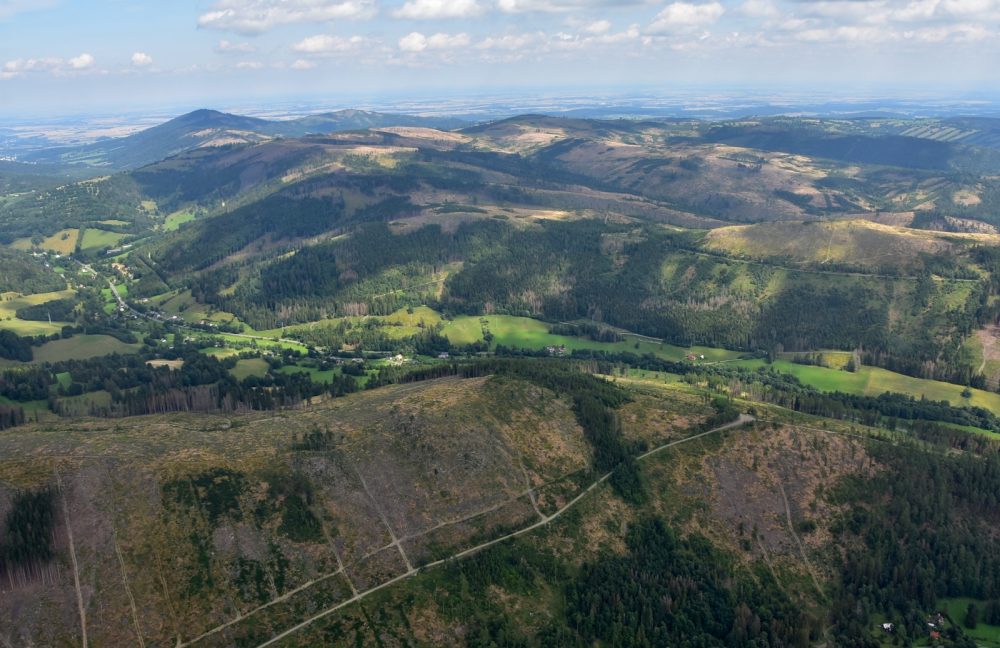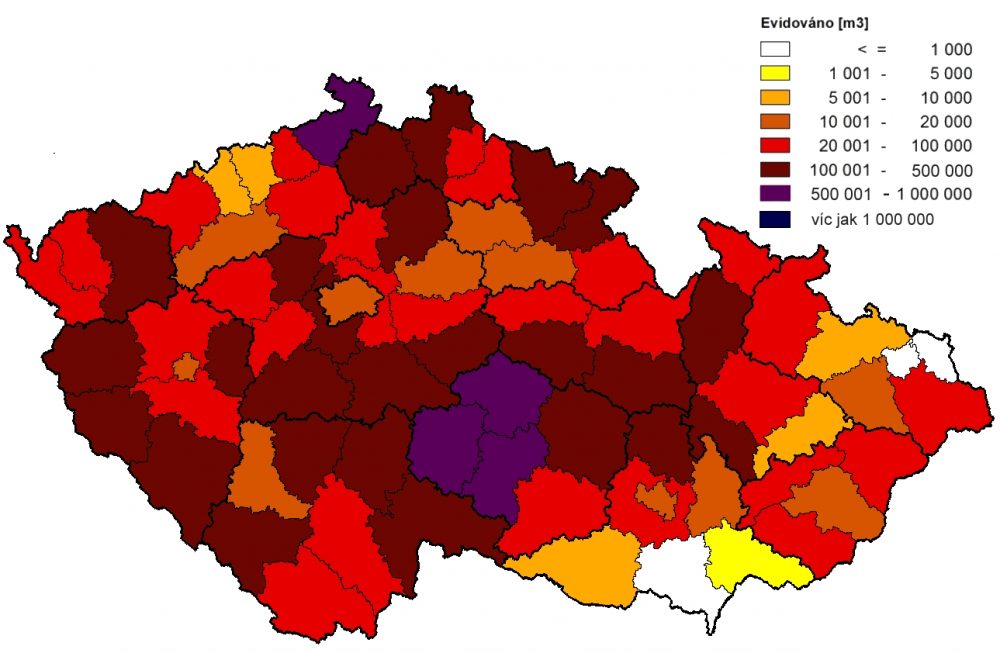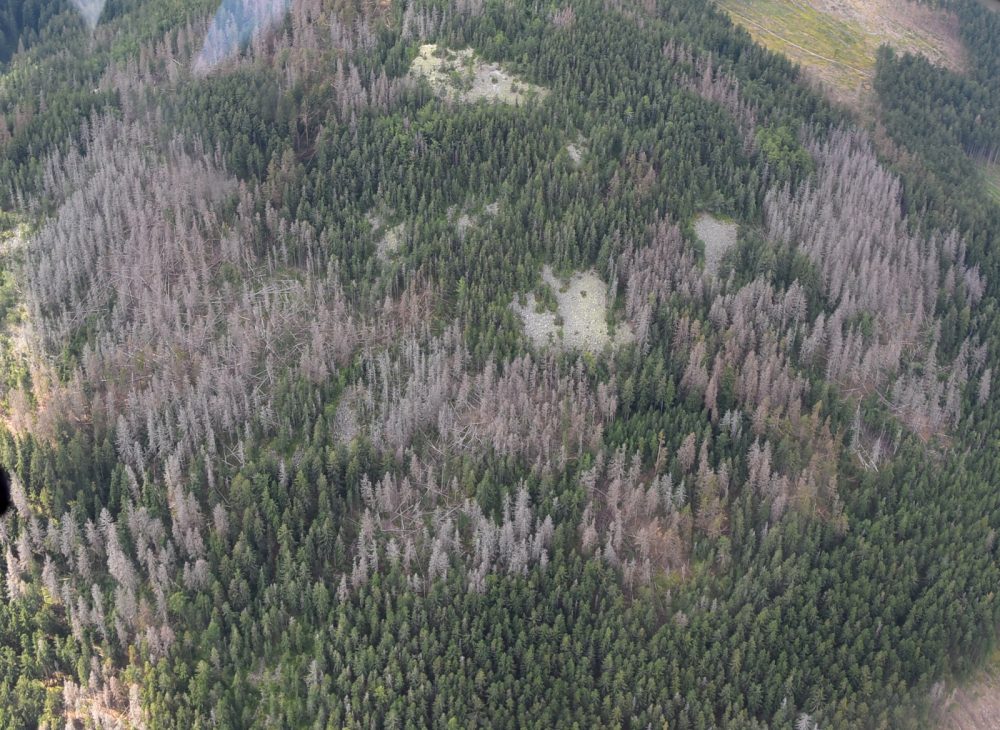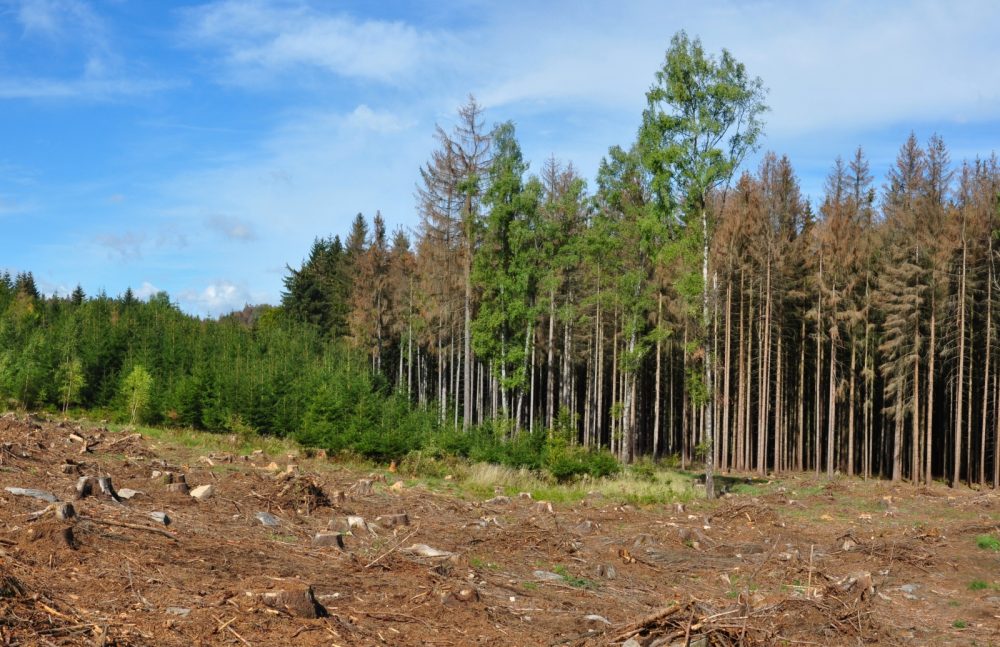The culmination of the bark beetle calamity is over, maybe
Let us look back at the course of the bark beetle calamity in 2021 and let us try to guess what awaits us this year. The colder and rainier weather in 2021 was a favourable factor in the fight against the forest bark beetle. Significantly colder spring had a significant negative effect on the course of flight activity of insects harmful under the bark and their development. According to data from the records of the Forest Protection Service, the volume of forest damage due to all harmful effects decreased by approximately one third year-on-year, from 19.8 million m3 to 13.8 million m3. The current bark beetle calamity culminated in 2020. Now, it is slowly receding.
As every year, the Forest Protection Service (LOS) published the Forest Protection Newsletter with the subtitle Harmful Factors in the Forests of the Czech Republic 2021/2022 (Volume 25, 2022) /Zpravodaj ochrany lesa. Škodliví činitelé v lesích Česka 2021/2022 (Svazek 25, 2022)/. This publication describes, among other things, the main problems in forest protection in the Czech Republic in 2021 and the forecast for 2022. It provides a lot of information about the course of the bark beetle calamity and the health of forests.
 According to the LOS records, approximately 9.7 million m3 of wood mass was damaged by the action of biotic harmful factors in 2021. For comparison, in 2020 it was 15.4 million m3, in 2019 14.8 million m3 and in 2018 8.6 million m3. The long-term overgrowth of under bark insects still plays a completely dominant role.
According to the LOS records, approximately 9.7 million m3 of wood mass was damaged by the action of biotic harmful factors in 2021. For comparison, in 2020 it was 15.4 million m3, in 2019 14.8 million m3 and in 2018 8.6 million m3. The long-term overgrowth of under bark insects still plays a completely dominant role.
Photo: extensive calamity clear areas after processing of random bark beetle damages, Silesia, Bruntál, 2021, VÚLHM archive
In 2021, almost 9.5 million m3 of harvested spruce wood damaged and destroyed by bark beetle was registered, which represents the first year-on-year decrease after eight years (since 2012) of a permanent increase of this factor. However, these are still highly calamity volumes of bark beetle damages. Compared to 2020, when approximately 14.9 million m3 of bark wood was registered, this is a decrease of approximately 5.4 million m3. In 2019, approximately 14.5 million m3 was registered, and in 2018 it was approximately 8.4 million m3.
The reports for 2021, which were submitted to the LOS, represent 67% of the total forest area. If the volume recorded in 2021 was recalculated to the total area of forests in the Czech Republic, we would reach a value of more than 14 million m3 of harvested spruce bark beetle wood!
The main pest is the spruce bark beetle (Ips typographus L.), which is usually accompanied by pine bark beetle (Pityogenes chalcographus L.) and also by northern bark beetle (Ips duplicatus Sahlb.), currently in most areas.
 According to the regions, in 2021 the situation was most dramatic in the Vysočina region (approx. 2.1 million m3) and in the Central Bohemian region (approx. 1.4 million m3). More than 0.5 million m3 of harvested bark beetle wood was also registered in the Pilsen region (approx. 1.0 million m3), South Bohemia region (approx. 0.9 million m3), Ústí nad Labem region (approx. 9 million m3), Liberec (approx. 0.8 million m3) and Pardubice regions (approx. 0.6 million m3).
According to the regions, in 2021 the situation was most dramatic in the Vysočina region (approx. 2.1 million m3) and in the Central Bohemian region (approx. 1.4 million m3). More than 0.5 million m3 of harvested bark beetle wood was also registered in the Pilsen region (approx. 1.0 million m3), South Bohemia region (approx. 0.9 million m3), Ústí nad Labem region (approx. 9 million m3), Liberec (approx. 0.8 million m3) and Pardubice regions (approx. 0.6 million m3).
The predominance of infested stands is located at altitudes of up to about 800 m, mountainous locations are less affected so far.
Map: registered volume of spruce bark beetle wood in the Czech Republic in 2021, VÚLHM archive
The course of weather during the flight activity of the bark beetle helped to improve the health of forest trees even more noticeably than in 2020, and slowed down the spread of bark beetle, which also suffered from increased mortality in gallery patterns caused by internal competitive influences and external abiotic and biotic factors.
The more favourable weather situation in 2020 and 2021 (in terms of precipitation totals and the course of temperatures over the last ten years) dampened the further expansion of the bark beetle calamity. In parallel with the improving sales situation on the wood market, resp. with the increase in raw wood prices, forest owners and managers have the opportunity to “catch up with bark beetle”, finally.
Of the mentioned 9.5 million m3 of registered bark beetle harvestings, only a small part (approx. 20–30%) was extracted and effectively remediated in time. For this reason, spruce stands in the Czech Republic continue to be in considerable danger. So far, during the years 2015–2021, bark beetle attacked approximately 85–90 million m3 of spruce wood. For the comparative information, the “living” stock of spruce stands was estimated to be approximately 400 million m3, in September 2019.
 Photo: extensive infestation of spruce stands by bark beetle in the nature reserve Suchý vrch, Silesia, Vrbno pod Pradědem, 2021, archive VÚLHM
Photo: extensive infestation of spruce stands by bark beetle in the nature reserve Suchý vrch, Silesia, Vrbno pod Pradědem, 2021, archive VÚLHM
In recent years, deteriorating tree health and an overgrowth of bark beetle have not just been a case of spruce, but also of other species, mainly coniferous ones.
Scots pine is infested mainly in the area of southern and southwestern Moravia and also in central and eastern Bohemia by a number of bark beetle species. In 2021 about 70 thousand. m3 of harvested pine bark wood was recorded (in 2020 it was almost 125 thousand m3). Among the most affected regions (over 10 thousand m3) in 2021 were the South Moravia region (24 thousand m3) and the Central Bohemia region (14 thousand m3).
After an eruptive increase in the silver fir by infestation of bark beetle in 2020 (bark beetle harvesting in the range of approximately 115 thousand m3), there was a year-on-year decrease and return to the 2018 and 2019 volumes, when approximately 8 thousand m3 was recorded. Most of the bark beetle attacks were located in the Central Bohemian Region (5.5 thousand m3).
In 2021, the volume of harvesting European larch bark beetle wood was doubled year-on-year, i.e. approximately 12,000 m3. One third of this amount was logged in South Moravia.
In the weakened stands with ash, the secondary occurrence of bark beetle persists after the action of fungal diseases; in 2021, about 2.8 thousand m3 of harvested ash wood were recorded.
The extent of damage to coniferous seedlings by pine bark beetle has a rather increasing tendency, as this bark beetle benefits from a large area of renewed clearings and from a large number of attractive stumps for him. In 2021, the damage caused by adult pine weevil was recorded in an area of about 3 thousand ha. The largest damage (over 500 ha) was reported in the Central Bohemian and South Bohemian regions and in the Vysočina region. In this year, a significant improvement cannot be expected, as the damage caused by the bark beetle will continue to increase, especially in areas with extensive bark beetle calamity.
 General outlook for 2022
General outlook for 2022
In consequence of favourable agreement of various influences, for example as weather conditions which are unsuitable for the development of bark beetle, improvement of moisture balance (and thus their vitality) of spruce stands, improvement of the situation on the wood market, together with the decrease in spruce stands, which are the most attractive for bark beetle, especially in the lower and middle positions, the further expansion of the ongoing bark beetle calamity in spruce stands has practically stopped.
The process to the basic state of bark beetle occurrence, resp. to the limits of their economic harmfulness, it is still very long and not easy, and only in the coming months will indicate whether the decline of infestation by bark beetle will continue this year or whether the situation will worse again.
The course of the weather during last autumn, winter and this spring is not very optimistic, and there is no indication yet as this spring should be at least a little like last spring – cold and rainy. Therefore, it is necessary not to under estimate anything in the field of forest protection against bark beetle and to focus as much as possible on capturing the overwintering generation of beetle and their offspring.
Possible climatic extremes could lead to a worsening of the bark beetle situation and to a year-on-year increase in the volume of bark beetle infestation, resp. bark beetle harvestings.
 In addition to spruce, bark beetle overgrowth will endanger a number of other (especially coniferous) forest tree species, such as Scots pine, European larch or silver fir.
In addition to spruce, bark beetle overgrowth will endanger a number of other (especially coniferous) forest tree species, such as Scots pine, European larch or silver fir.
The very low number of leaf-eating and sucking insects in 2021, combined with the favourable weather conditions, creates a precondition for the limited development and occurrence of this group of insects also for 2022.
There is no need to talk about the continuing threat of increased damage caused by the overpopulated cloven-hoofed game, after all, the effective solution is not in the power of forest protection.
Regarding the course of the weather in recent months, it is possible to expect an increase in the importance of pathogens harmful in connection with drought stress. The main risk will be honey fungus, Diploidia mould, Diploidia sapinea fungi, or common mistletoe. As in recent years, the increase in dying ash, caused by ash necrosis and root decays, has raised long-standing concerns.
More information can be found in the publication Forest Protection Newsletter (Zpravodaj ochrany lesa), subtitle Harmful Factors in the Forests of the Czech Republic (Škodliví činitelé v lesích Česka) 2021/2022 (Volume 25, 2022), downloadable here.
Authors of the article The main problems in forest protection in the Czech Republic in 2021 and the forecast for 2022 (Hlavní problémy v ochraně lesa v Česku v roce 2021 a prognóza na rok 2022): Jan Lubojacký, František Lorenc, Michal Samek, Miloš Knížek, Jan Liška, VÚLHM, v. v. i.
Prepared by: Jan Řezáč, translated by: Josef Frýdl
Introductory photo: bark beetle-destroyed forests in the Vysočina region, author Jan Řezáč
